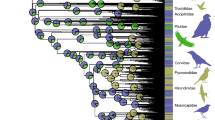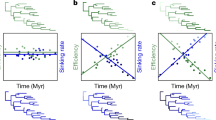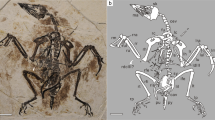Abstract
Gliding flight has independently evolved many times in vertebrates. Direct evidence of gliding is rare in fossil records and is unknown in mammals from the Mesozoic era. Here we report a new Mesozoic mammal from Inner Mongolia, China, that represents a previously unknown group characterized by a highly specialized insectivorous dentition and a sizable patagium (flying membrane) for gliding flight. The patagium is covered with dense hair and supported by an elongated tail and limbs; the latter also bear many features adapted for arboreal life. This discovery extends the earliest record of gliding flight for mammals to at least 70 million years earlier in geological history, and demonstrates that early mammals were diverse in their locomotor strategies and lifestyles; they had experimented with an aerial habit at about the same time as, if not earlier than, when birds endeavoured to exploit the sky.
This is a preview of subscription content, access via your institution
Access options
Subscribe to this journal
Receive 51 print issues and online access
$199.00 per year
only $3.90 per issue
Buy this article
- Purchase on Springer Link
- Instant access to full article PDF
Prices may be subject to local taxes which are calculated during checkout



Similar content being viewed by others
References
Shen, Y.-b., Chen, P.-j. & Huang, D.-y. Age of fossil conchostracans from Daohugou of Ningcheng, Inner Mongolia [in Chinese with English abstract]. J. Stratigr. 27, 311–313 (2003)
Chen, W. et al. Isotope geochronology of the fossil-bearing beds in the Daohugou area, Ningcheng, Inner Mongolia [in Chinese]. Geol. Bull. Chin. 23, 1165–1169 (2004)
Zhang, J.-f. Discovery of Daohugou Biota (Pre-Jehol Biota) with a discussion on its geological age [in Chinese with English abstract]. J. Stratigr. 26, 173–177 (2002)
He, H.-y. et al. 40Ar/39Ar dating of ignimbrite from Inner Mongolia, northeastern China, indicates a post-Middle Jurassic age for the overlying Daohugou Bed. Geophys. Res. Lett. 31, L20609, doi:10.1029/2004GL020792. (2004)
Wang, X.-l. et al. Stratigraphy and age of the Dauhugou bed in Ningcheng, Inner Mongolia. Chin. Sci. Bull. 50, 2369–2376 (2005)
Swisher, C. C. et al. Cretaceous age for the feathered dinosaurs of Liaoning, China. Nature 400, 58–61 (1999)
Sigogneau-Russell, D. Two possibly aquatic triconodont mammals from the Early Cretaceous of Morocco. Acta Palaeontol. Pol. 40, 149–162 (1995)
Cifelli, R. L., Wible, J. R. & Jenkins, F. A. Jr. Triconodont mammals from the Cloverly Formation (Lower Cretaceous), Montana and Wyoming. J. Vert. Paleontol. 18, 237–241 (1998)
Kielan-Jaworowska, Z., Cifelli, R. L. & Luo, Z.-x. Mammals from the Age of Dinosaurs: Origins, Evolution and Structure (Columbia Univ. Press, New York, 2004)
Ji, Q., Luo, Z.-x., Yuan, C.-x. & Tabrum, A. R. A swimming mammaliaform from the Middle Jurassic and ecomorphological diversification of early mammals. Science 311, 1123–1127 (2006)
Rowe, T. B. Definition, diagnosis, and origin of Mammalia. J. Vert. Paleontol. 8, 241–264 (1988)
Storch, G., Engesser, B. & Wuttke, M. Oldest fossil record of gliding in rodents. Nature 379, 439–441 (1996)
Rayner, J. M. V. Flight adaptations in vertebrates. Symp. Zool. Soc. Lond. 48, 137–172 (1981)
Norberg, U. M. in Functional Vertebrate Morphology (eds Hildebrand, M., Bramble, D. M., Liem, K. F. & Wake, D. B.) 129–158 (The Belknap Press, Harvard Univ., Massachusetts, 1985)
Norberg, U. M. Evolution of vertebrate flight: an aerodynamic model for the transition from gliding to active flight. Am. Nat. 126, 303–327 (1985)
Johnson-Murray, J. Myology of the gliding membranes of some Petauristine rodents (genera: Glaucomys, Pteromys, Petinomys, and Petaurista). J. Mamm. 58, 374–384 (1977)
Runestad, J. A. & Ruff, C. B. Structural adaptations for gliding mammals with implications for locomotor behaviour in paromomyids. Am. J. Phys. Anthrop. 98, 101–119 (1995)
Thorington, R. W. & Heaney, L. R. Body proportions and gliding adaptations of flying squirrels. J. Mamm. 62, 101–114 (1981)
Ji, Q., Luo, Z. & Ji, S. A Chinese triconodont mammal and mosaic evolution of the mammalian skeleton. Nature 398, 326–330 (1999)
Hu, Y., Wang, Y., Luo, Z. & Li, C. A new symmetrodont mammal from China and its implications for mammalian evolution. Nature 390, 137–142 (1997)
Ji, Q. et al. The earliest known eutherian mammal. Nature 416, 816–822 (2002)
Luo, Z.-x., Ji, Q., Wible, J. R. & Yuan, C.-x. An Early Cretaceous tribosphenic mammal and metatherian evolution. Science 302, 1934–1940 (2003)
Lindenmayer, D. Gliders of Australia: A Natural History (Univ. of New South Wales Press, New South Wales, 2002)
Argot, C. Functional-adaptive analysis of the hindlimb anatomy of extant marsupials and the paleobiology of the Paleocene marsupials Mayulestes ferox and Pucadelphys andinus.. J. Morphol. 253, 76–108 (2002)
Jenkins, F. A. & Parrington, F. R. The postcranial skeletons of the Triassic mammals Eozostrodon, Megazostrodon and Erythrotherium.. Phil. Trans. R. Soc. Lond. B 273, 387–431 (1976)
Hu, Y., Meng, J., Wang, Y. & Li, C. Large Mesozoic mammals fed on young dinosaurs. Nature 433, 149–153 (2005)
Beard, K. C. Gliding behaviour and palaeoecology of the alleged primate family Paromomyidae (Mammalia, Dermorptera). Nature 345, 340–341 (1990)
Beard, K. C. (1993). in Primates and Their Relatives in Phylogenetic Perspective (ed. MacPhee, R. D. E.) 63–90 (Plenum, New York, 1993)
Hamrick, M. W., Rosenman, B. A. & Brush, J. A. Phalangeal morphology of the Paromonyidae (?Primates, Plesiadapiformes): the evidence for gliding behavior reconsidered. Am. J. Phys. Anthrop. 109, 397–413 (1999)
Szalay, F. S. & Lucas, S. G. in Primates and Their Relatives in Phylogenetic Perspective (ed. MacPhee, R. D. E.) 187–226 (Plenum, New York, 1993)
Bloch, J. I. & Boyer, D. M. Grasping primate origins. Science 298, 1606–1610 (2002)
Caple, G., Balda, R. P. & Willis, W. R. The physics of leaping animals and the evolution of preflight. Am. Nat. 121, 455–476 (1983)
Stafford, B. J., Thorington, R. W. & Kawamichi, T. Positional behavior of Japanese giant flying squirrels (Petaurista leucogenys). J. Mamm. 84, 63–271 (2003)
Norberg, U. M. Vertebrate flight: mechanics, physiology, morphology, ecology and evolution. Zoophysiol. 27, 1–291 (1990)
Lillegraven, J. A., Kielan-Jaworowska, Z., Clemens, W. A. . Mesozoic Mammals: The First Two-Thirds of Mammalian History (Univ. of California Press: Berkeley, 1979)
Nowak, R. M. Walker’s Mammals of the World 6th edn (Johns Hopkins Univ. Press, Baltimore, 1999)
Norberg, U. M. in European Bat Research (eds Hanák, V., Horácek, I. & Gaisler, J.) 197–211 (Charles Univ. Press, Praha, 1989)
Fenton, M. B., Audet, D., Obrist, M. K. & Rydell, J. Signal strength, timing, and self-deafening: the evolution of echolocation in bats. Paleobiology 21, 229–242 (1995)
Simmons, N. B. & Geisler, J. H. Phylogenetic relationships of Icaronycteris, Archaeonycteris, Hassianycteris, and Palaeochiropteryx to extant bat lineages, with comments on the evolution of echolocation and foraging strategies in Microchiroptera. Bull. Am. Mus. Nat. Hist. 235, 1–182 (1998)
Gunnell, G. F. & Simmons, N. B. Fossil evidence and the origin of bats. J. Mamm. Evol. 12, 209–246 (2005)
Thorington, R. W. Jr. Flying squirrels are monophyletic. Science 225, 1048–1050 (1984)
Jackson, S. M. Glide angle in the genus Petaurus and a review of gliding in mammals. Mamm. Rev. 30, 9–30 (1999)
Swofford, D. L. PAUP*. Phylogenetic Analysis Using Parsimony and Other Methods. Version 4 (Sinauer Assoc., Sunderland, Massachusetts, 2002)
Maddison, W. P. & Maddison, D. R. Mesquite: a Modular System for Evolutionary Analysis. Version 1.06 〈http://mesquiteproject.org〉 (2005a)
Maddison, W. P. & Maddison, D. R. MacClade: Analysis of Phylogeny and Character Evolution. Version 4.08 (Sinauer Assoc., Sunderland, Massachusetts, 2005b)
Acknowledgements
We thank Z. Zhou, F. Zhang, X. Xu, Y. Wang, F. Jin, and J. Zhang for help in coordinating the research and fieldwork; S. Xie for specimen preparation; M. Yang for drawing Supplementary Fig. 13; and L. Meeker for X-radiography. The research has been funded by the Chinese Academy of Sciences, the National Natural Science Foundation of China; and Major Basic Research Projects of the Ministry of Science and Technology, China. The research of Y.H. is also supported by a fellowship from the American Museum of Natural History, New York.
Author information
Authors and Affiliations
Corresponding authors
Ethics declarations
Competing interests
Reprints and permissions information is available at www.nature.com/reprints. The authors declare no competing financial interests.
Supplementary information
Supplementary Notes
This file contains details on the following: A, Preservation of the specimen. B, Age of the Daohugou Beds. C, Comparative description. D, Notes on Limb Measurements. E, Character list and data matrix. F, Phylogenetic analysis. (DOC 606 kb)
Supplementary Figures 1
This file contains Supplementary Figures 1–5. (DOC 3310 kb)
Supplementary Figures 2
This file contains Supplementary Figures 6–13. (DOC 4029 kb)
Supplementary Tables
This file contains Supplementary Tables 1–7. (DOC 54 kb)
Rights and permissions
About this article
Cite this article
Meng, J., Hu, Y., Wang, Y. et al. A Mesozoic gliding mammal from northeastern China. Nature 444, 889–893 (2006). https://doi.org/10.1038/nature05234
Received:
Accepted:
Issue Date:
DOI: https://doi.org/10.1038/nature05234
This article is cited by
-
Insights into the formation and diversification of a novel chiropteran wing membrane from embryonic development
BMC Biology (2023)
-
A new method for examining the co-occurrence network of fossil assemblages
Communications Biology (2023)
-
On the way from Asia to America: eutriconodontan mammals from the Early Cretaceous of Yakutia, Russia
The Science of Nature (2023)
-
Petrosal morphology of the Early Cretaceous triconodontid Astroconodon from the Cloverly Formation (Montana, USA)
Journal of Mammalian Evolution (2023)
-
Comparison of Hindlimb Muscle Architecture Properties in Small-Bodied, Generalist Mammals Suggests Similarity in Soft Tissue Anatomy
Journal of Mammalian Evolution (2022)
Comments
By submitting a comment you agree to abide by our Terms and Community Guidelines. If you find something abusive or that does not comply with our terms or guidelines please flag it as inappropriate.



